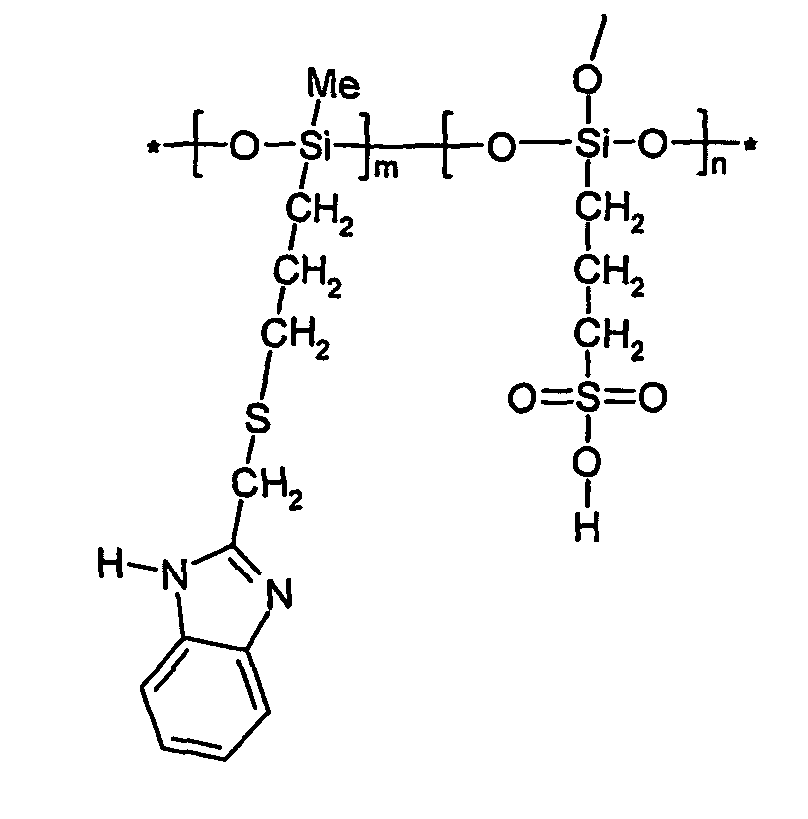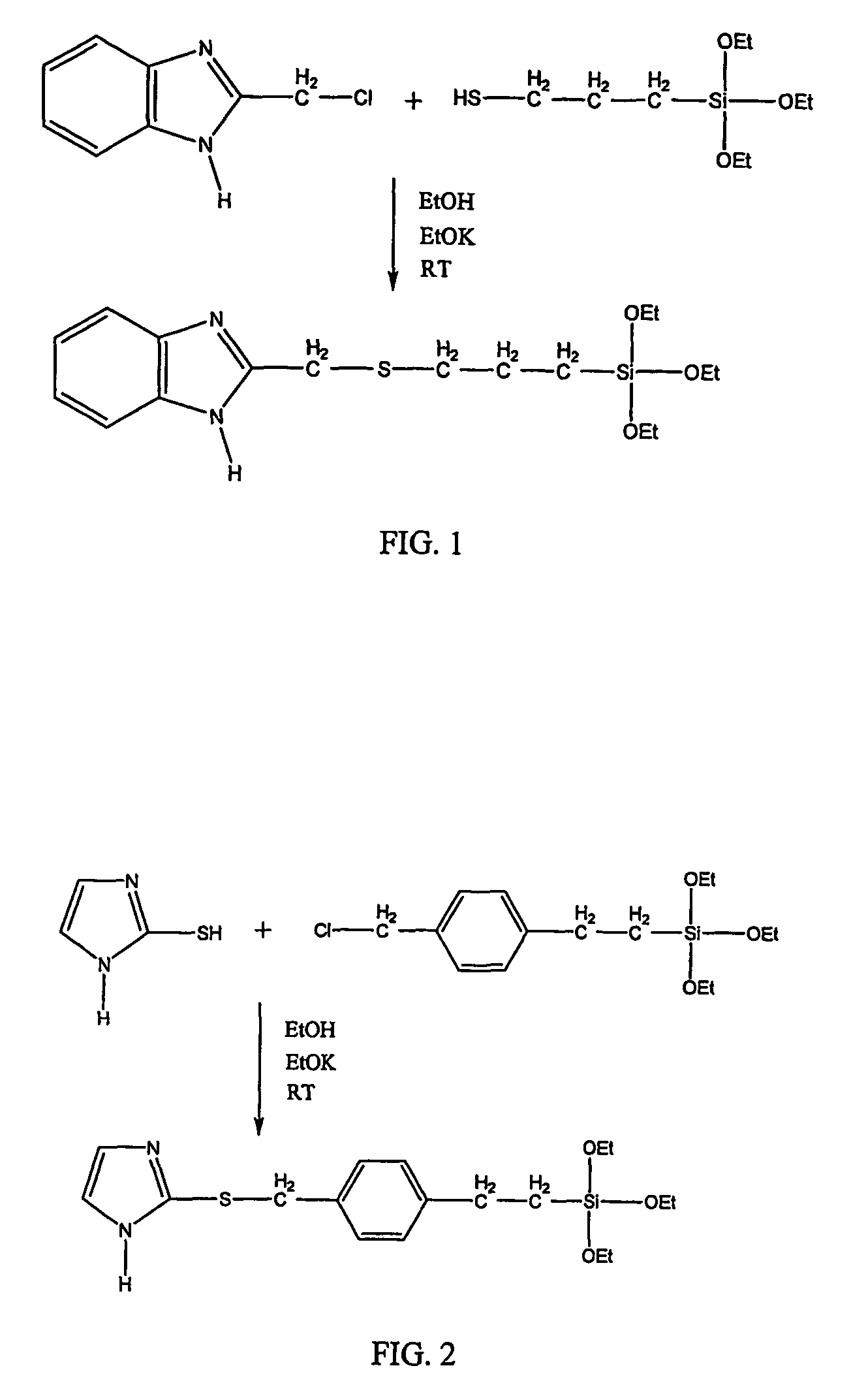Polymer electrolyte membranes (PEMs) based on imidazole ring terminated flexible branches grafted on hybrid inorganic-organic polymers
a technology of polymer electrolyte and imidazole ring, which is applied in the field of proton conducting materials, can solve the problems of poor proton conductivity of conventional perfluorosulfonic polymers, such as nafion, and suffer serious disadvantages in the field of proton conductivity in low humidity and at higher temperature range, and achieves dimensional changes in different humidity
- Summary
- Abstract
- Description
- Claims
- Application Information
AI Technical Summary
Problems solved by technology
Method used
Image
Examples
example 1a
Synthesis of 2-trimethoxysilylpropylthiomethyl-1H-benzimidazole
[0037]
[0038]0.01 mole 2-(chloromethyl)benzimidazole was dissolved in 25 ml of methanol by stirring in a 3-neck flask with a condenser and a Ar gas line. 0.01 mole 3-mercaptopropyltrimethoxysilane was added to the solution, stirred for 10 minutes, and then 0.01 mole KOH dissolved in 10 ml methanol was added dropwise. After the reaction was completed in 12 hours at room temperature under the protection of Ar, solution was filtrated, and the white precipitate KCl was removed. After the solvent ethanol was evaporated from the filtrate in vacuum, brown viscous liquid material 2-trimethoxysilylpropylthiomethyl-1H-benzimidazole was obtained. FTIR of the obtained material shows that the characteristic peaks of aromatic ring-CH2—Cl at 640 cm−1 and 933 cm−1 disappeared and the peak of —CH2—S— at 596 cm−1 and that of C—S—C at 696 cm−1 appeared.
example 1b
[0039]FIG. 1 further illustrates a scheme used to synthesize 2-triethoxysilylpropylthiomethyl-1H-benzimidazole (BISSi, triethoxy analog of example 1a)
[0040]1.9634 g 3-mercaptopropyltrimethoxysilane (10 mmle) was dissolved in 10 ml of anhydrous ethanol, mixed with 0.84 g of potassium ethoxide (10 mmole, 24% solution in ethyl alcohol), and then stirred for 10 minutes. 1.6661 g of 2-(chloromethyl)benzimidazole (10 mmole) in 20 ml was added dropwise to the above mixture and stirred for about 12 hours. TLC was used to check if the reaction has been completed. The white precipitate KCl was removed by filtration. About 2.2 g of 2-triethoxysilylpropylthiomethyl-1H-benzimidazole was separated from the filtrate through a silicate gel column chromatography eluted with ethyl acetate and hexane (50 / 50 in volume) (60% yield). It was a yellow oil-like liquid. 1H-NMR in CDCl3: δ=10.80 (1H, brs), 7.17-7.66 (4H, m), 3.95 (2H, s), 3.75 (6H, m), 2.50 (2H, t, JH-H=7.30), 1.65 (2H, m), 1.54 (9H, t, JH-H=...
example 2a
Synthesis of 2-[(p-2-trimethoxysilylethylphenylmethyl)thio]-1H-imidazole (ImSSi)
[0041]
[0042]2-[(p-trimethoxysilylethylphenylmethyl)thio]-1H-imidazole (InSSi) was synthesized from 2-mercaptoimidazole and ((chloromethyl)phenylethyl)-trimethoxysilane using a similar method to that described above in Example 1a.
[0043]0.01 mole 2-mercaptoimidazole was dissolved in 25 ml of methanol by stirring in a 3-neck flask with a condenser and a Ar gas line. 0.01 mole ((chloromethyl)phenylethyl)-trimethoxysilane was added to the solution, stirred for 10 minutes, and then 0.01 mole KOH dissolved in 10 ml methanol was added dropwise. After the reaction was completed in 12 hours at room temperature under the protection of Ar, the solution was filtrated, and the white precipitate KCl was removed. The solvent methanol was evaporated from the filtrate in vacuum.
[0044]The obtained ImSSi was a light yellow viscous liquid. FTIR of the hydrolyzed and condensed solids from BISSi (as prepared using Example 1a) ...
PUM
| Property | Measurement | Unit |
|---|---|---|
| temperature | aaaaa | aaaaa |
| proton conductivity | aaaaa | aaaaa |
| proton conductivity | aaaaa | aaaaa |
Abstract
Description
Claims
Application Information
 Login to View More
Login to View More - R&D
- Intellectual Property
- Life Sciences
- Materials
- Tech Scout
- Unparalleled Data Quality
- Higher Quality Content
- 60% Fewer Hallucinations
Browse by: Latest US Patents, China's latest patents, Technical Efficacy Thesaurus, Application Domain, Technology Topic, Popular Technical Reports.
© 2025 PatSnap. All rights reserved.Legal|Privacy policy|Modern Slavery Act Transparency Statement|Sitemap|About US| Contact US: help@patsnap.com



